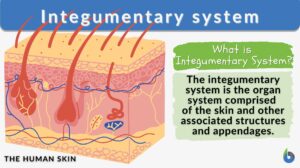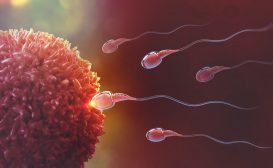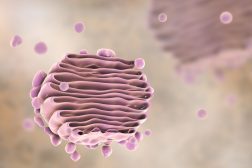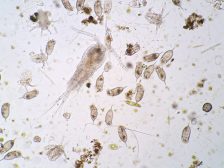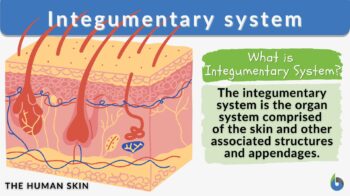
Integumentary system
n., plural: integumentary systems
[ɪnˈtɛɡ.jʊ.məntə.ɹi ˈsɪstəm]
Definition: The outermost layer of the body
Table of Contents
Integumentary System Definition
The integumentary system is the outermost layer of the body. The animal body, in particular, is the largest organ system of the body that forms the first line of defense or the physical barrier against the external environment and pathogens. In humans, a set of four major organs combine to form the integumentary system. The integumentary system includes the following:
- Skin, which includes the epidermis, dermis, and hypodermis
- Nails
- Hairs
- Exocrine glands
The integumentary system does not only protect the body from pathogens, sunlight, temperature, and injury, but it also helps in the maintenance of body homeostasis and provides a sense of touch and temperature. Additionally, the integumentary system also helps to maintain fluid balance in the body, removal waste from the body or the elimination of waste from the body, synthesis of essential vitamins for the body like vitamin D, and deep tissue protection. All the organs of the integumentary system work in sync to execute the essential body functions.
Watch this vid about the integumentary system:
Biology definition:
The integumentary system is the organ system consisting of the skin and associated structures and appendages, e.g. glands, hair, nails, scales, hooves, feathers, etc. Its functions include protection (against injurious agents like unfavorable external conditions, dehydration, chemicals, and pathogens), homeostasis, thermoregulation, perspiration (for excreting waste materials), sensation for touch, pressure, pain, heat, and cold, vitamin D synthesis when exposed to UV light, storage of water, fat, glucose, and vitamin D, tissue repair from minor injuries, and so on. In certain animals, the integumentary system also helps them to blend into their surroundings. Chameleons, for instance, are capable of camouflage. Their skin is capable of changing color to match their surroundings.
The integumentary system is part of the different organ systems that make up an individual. In humans and other animals, the organ systems, apart from the integumentary system, include the lymphatic system, muscular system, nervous system, reproductive system, urinary system, respiratory system, skeletal system, and immune system.
Organs Of The Integumentary System
Following organs combine together to form the integumentary system
Skin
The skin is the outer layer of the body and the largest organ of the human body that covers the whole body from head to toe. Except at sensitive areas like eyelids (thinnest skin) and soles of the feet (thicker skin), the human skin is approximately 2 mm thick throughout and encompasses ~ 1.5 to 2 m2 of the body surface area. The skin contributes to ~12 to 15% of the body weight.
The superficial epidermis and the deeper dermis are the two primary layers of the human skin. Epidermis is the outermost and tough layer that forms the first line of defense of the human body. Epidermis is made up of stratified squamous epithelial cells and is further subdivided into four to five layers:
- Stratum corneum
- Stratum granulosum
- Stratum spinosum
- Stratum basale
- An additional layer is present in the soles of the feet and palm (having thicker skin) and is known as stratum lucidum. Stratum lucidum is present between stratum corneum and stratum granulosum.
The basale cells have stem cells that divide and generate epidermal cells that move from the basal layer towards the stratum corneum.
Epidermis does not have a blood supply and is dependent upon dermis for the nutrients. Dermis is present below the epidermis layer and connective tissue. The connective tissue forms the underlying connective tissue framework. It is subdivided into two layers:
- Superficial papillary dermis
- Deep reticular layer
The papillary dermis layer creates finger-like projections into the epidermis which are known as dermal papillae. The papillary dermis layer is highly vascularized and has loose connective tissue while the reticular dermis layer is made up of a more dense connective tissue network.
This reticular layer of the dense irregular connective tissue provides elasticity to the skin. The underlying dermis layer houses all the nerve supply, blood and lymph vessels, hair follicles, sweat glands, and various other structures.
Below the dermis and between all the organs is the hypodermis. This layer is largely composed of subcutaneous tissue and is made up of adipose tissue and loose areolar tissue. Hypodermis provides insulation and cushioning to the organs, as it is made up of adipose tissue. Also, this layer connects the skin with the underlying structures through muscles (Figure 1).

NOTE IT!
Skin without hairs, as on the palm of the hands and soles of feet, is known as glabrous skin. This skin when exposed to water for a long time gets crinkled.
Nails
Nails are made up of protein called keratin and these keratin structures present at the tip of fingers and toes. The nail grows due to the production of cells from the nail matrix that pushes the old cells toward the distal end. The visible part of the nail is the nail plate that covers the nail bed. Nails protect the toes and fingertips. Also, nails help in a more precise movement and increase the sensation. (Figure 2)
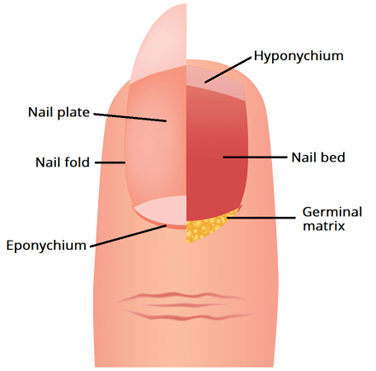
Hair
Hairs protrude out from the epidermis. However, hair roots are present in the dermis. The outer visible portion of hair is known as the hair shaft whereas the part of the hair present in the skin is known as the hair follicle. The hair follicle has a bulbous structure known as the hair bulb where active growth of hair occurs that eventually leads to vertical growth of the hair shaft.
Hairs are classified as follows:
- Hormone-dependent hair – thick hair in the chest, axillary and pubic area, etc
- Androgen-independent vellus hair – Hair present in the rest of the body
Except on lips, soles, palms, and portions of external genitalia, hairs are present throughout the body.
Depending on the hormonal status and nutrients, hair growth can be in any of the following stages:
- Anagen (growth phase)
- Catagen (nonproliferative phase)
- Telogen (resting phase)
Hairs function to provide mechanical protection to the skin, regulate body temperature, and increased sensory function. In the dermis, the arrector pili muscles attach to the hair and this muscle keeps the hair shaft in standing position, and the air, which gets trapped between the shaft, helps in skin temperature regulation. (Figure 3)
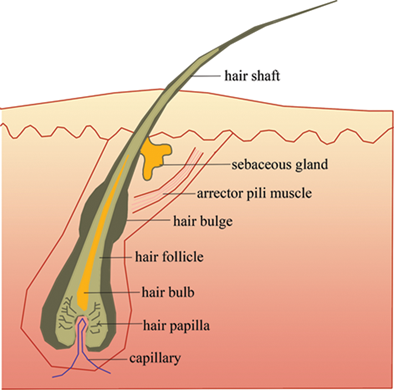
Exocrine Glands
Four exocrine glands are associated with the skin, namely,
- Sudoriferous glands
- Sebaceous glands
- Ceruminous glands
- Mammary glands
The sudoriferous glands are commonly known as sweat glands. The sweat glands are further subdivided into two types: eccrine and apocrine glands.
- » Eccrine sweat glands are present throughout the body that primarily produces serous fluid to maintain body temperature. The apocrine sweat glands are present in the pubic area and the axilla and produce protein-rich milky sweat.
- » In apocrine glands, bacterial breakdown of the organic sweat content results in body odor.
Sebaceous glands form the pilosebaceous unit that consists of the hair follicle, hair, and arrector pili muscle. Sebaceous glands secrete protective films. Sebaceous glands produce an oily substance called sebum. Sebum, an oily substance, is a lipid mixture that forms a protective layer over the skin that helps to provide additional protection to the skin and controls fluid loss from the body and thus helps in cell fluid maintenance. Also, this layer provides antimicrobial protection to the skin.
Ear wax is produced by ceruminous glands. Mammary glands, in turn, are specialized glands for milk production, particularly in female mammals that nourish their offspring.
Functions Of The Integumentary System
Barrier Function
The most apparent function of the integumentary system is to provide a barrier function against injury, pathogens, and environmental factors. Skin is made up of closely knit cells in multiple layers that provide physical protection.
- » The outermost layer of skin is made up of keratin that helps to withstand wear and tear by external environmental factors.
- » The dermis has nerve endings that provide the sensation (sensory nerve endings) to external stimuli, thus alerting the body against harmful stimuli or situations.
- » The hypodermis layer is primarily made up of adipose tissue thus providing a physical cushion to the internal organs.
- » The exocrine sebaceous gland produces a lipidic secretion that creates a protective film over the skin.
- » The nails are the hard covering to provide protection to the fingertips against the physical factor.
- » Hairs act as screens and keep away harmful particles from entering the body through ears, eyes, nose, etc.
- » The tiny hairs in the nose body filter harmful particles from entering the respiratory system.
Skin forms the first line of the defense system of the body that acts as a physical barrier that prevents pathogen entry through the skin. Skin cells are tightly packed with junction proteins that are further reinforced by the keratin filaments. Lipidic sebaceous layer and antimicrobial peptides (AMPs) form the bio-barrier on the skin that has the ability to disrupt microbial membranes. Skin cells like, dermal dendritic cells, macrophages, and glands produce AMPs like cathelicidins and defensins. Lamellar bodies present in the stratum corneum house lipidic constituents like sphingomyelin and glucosylceramides that possess antimicrobial activity. Immunity system cells are also found in skin like lymphoid and myeloid cells while certain cells like dendritic cells or Langerhans cells travel and activate the immune cells.
Wound healing
In the case of wound healing, the integumentary system stimulates the wound-healing process through various steps, namely,
- Homeostasis – Upon an injury, the tissue factors present in the subendothelial spaces of the skin trigger the cascade that results in clot formation and eventually restores homeostasis.
- Inflammation – During the inflammatory stage of wound healing, immune cells like monocytes and neutrophils, infiltrate the injury site to capture and clear out the pathogens and the debris formed at the injury site.
- Proliferation – During the proliferation stage of wound healing, cells like fibroblasts and keratinocytes, regenerate to form the granulation tissue. A new extracellular matrix is formed by a collagenous network of myofibroblasts and fibroblasts.
- Remodeling – It is the final phase of wound healing wherein the apoptotic cells clear out the non-required structures in order to restore the original structure. The matrix metalloproteases are released by the macrophages to clear out the excessive as well as immature collagen and eventually achieve the necessary extracellular matrix structure.
Thermoregulation
Skin is a highly vascular organ that has a large surface area as well. The vascular supply either undergoes vasoconstriction or vasodilation to conserve or dissipate the heat through the body. Blood vessels dilate to enhance the blood flow and dissipate/release heat when body heat increases. Together with the vascular system, sweat glands secrete sweat that evaporates to cool down the body. Hairs present on the skin also help in body temperature regulation. The air trapped between hairs provide the required insulation to the body especially when environmental temperature is low. Skin also has various nerve ending with thermoreceptors that helps in body thermoregulation.
Excretion
Through perspiration or sweating, excretion through the human body also occurs. Depending upon the lipidic/aqueous solubility, metabolites are excreted either through sweat or sebum. Vitamin B is excreted either through urine or in sweat.
Sensation and Chemical Synthesis
The primary source of vitamin D in the human body is sunlight. On exposure to sunlight, 7-dehydrocholesterol present in the skin is converted to vitamin D3 (cholecalciferol). Further, in the liver, cholecalciferol is hydroxylated, and later in the kidney hydroxylated cholecalciferol is converted to its active metabolite form, calcitriol (1,25-dihydroxy vitamin D). Calcitriol then increases the absorption of calcium in the gut which is essential for good bone health.
Skin is also supplied by a number of nerve supply that also has sensory receptors for touch, vibration, pain, and temperature. There are four major touch receptors in the skin, namely:
- Meissner corpuscle – These cells are capable of detecting movement across the skin.
- Pacinian corpuscle – These cells are capable of detection of high-frequency vibrations.
- Ruffini endings – These cells are capable of detecting stretching.
- Merkel cells – These cells are helpful in spatial imaging.
Tactile stimuli are picked up by hair cells and their linked longitudinal and circumferential lanceolate endings. While the free nerve endings present in the epidermis pick up the noxious stimuli. The adaptive and conductive speeds of these receptors vary and eventually define the response of the body to any stimuli.
Diseases Of The Integumentary System
Since the Integumentary system is the first line barrier as well as the defense system, it is exposed to a number of environmental factors making it susceptible to a number of diseases. In most pathophysiological conditions, the symptoms are visible directly in the Integumentary system, while certain pathophysiological symptoms may be an indirect indication of disease within the human body in other organs.
Skin disorders
1. Acne
Inflammation in the pilosebaceous unit causes acne. Acne can be an outcome of the excessive sebum production that clogs the skin pores or inflammation mediated by Cutibacterium acnes. Morphologically, acne can be open or closed comedones, nodules, papules, and pustules. All these acnes vary in size and appearance. Stress, trauma, diet, and hormonal imbalance can result in skin scne. Hormonal acne characteristically appears around the jawline and coincides with the menstrual cycle. Sebaceous glands overproduce the sebum when androgen levels are increased, that in turn increases the acne formation. This is because sebum provides a medium for Cutibacterium acnes that increases inflammation resulting in acne formation.
2. Atopic dermatitis
Atopic dermatitis is also known as eczema and can affect adults as well as children. Atopic dermatitis is a multifactorial disease that can be caused due to genetics, imbalance in immunity, and epidermal junction/barrier breakage. A protein, Filaggrin, present in the stratum corneum, links intermediate keratin filaments resulting in the formation of an impenetrable outer skin layer. The occurrence of defects in the Filaggrin breaks the skin barrier, which can result in excessive water loss. Excessive water loss is the primary characteristic of atopic dermatitis. Extensor surfaces and cheeks are the sites of appearance of atopic dermatitis in young patients while in older patients, flexural areas are the site of atopic dermatitis. Itching is the hallmark symptom of atopic dermatitis and the itching-scratch cycle leads to skin lichenification.
3. Psoriasis
In psoriasis, the skin has itchy rashes that turn into scaly patches and is found mostly seen on the knees, trunk, scalp, and elbows. The most common type of psoriasis is chronic plaque psoriasis which characteristically has well-marked erythematous plaques with an overlaid silvery scale. Almost 50% of patients’ lesions are pruritic. The suspected cause of psoriasis is the dysfunction in the skin’s immune system leads to keratinocyte hyperproliferation in the epidermis.
4. Cellulitis
Infection in the subcutaneous fat and deep dermis is presented as edema, erythema, and warm site. Skin barrier dysfunction leads to infection by Streptococcus pyogenes causing cellulitis.
5. Skin Cancer
Squamous cell carcinoma is a malignant tumor that occurs in the epidermal keratinocytes due to sun exposure.
Another type of cancer is basal cell carcinoma, which is the most common type of skin cancer. In this form of cancer, basal cells of the epidermis become cancerous. Ultraviolet radiation exposure is the primary cause of basal cell carcinoma.
Melanoma, a highly metastatic type of cancer, is characterized by the development of unusual growth on the skin or the development of a new pigment or increase in mole size. UV radiation exposure can cause melanoma. Melanoma can be of four forms: superficial spreading, nodular, lentigo maligna, and acral lentiginous.
6. Burns
Exposure to high temperatures, radiation, or chemicals can cause skin burns. Depending upon the depth of the burn site, it can be superficial, partial-thickness, full-thickness, or fourth-degree.
Hair disorders
1. Alopecia areata
Alopecia areata is an autoimmune disorder wherein excessive hair loss occurs. In this disorder, T-cells attack the hair bulb as a result of which, the hair follicle in the growth phase (anagen phase) gets transitioned into the non-proliferative phase (catagen phase) / resting phase (telogen phase). This results in excessive hair loss.
2. Folliculitis
As the name suggests, folliculitis is the inflammation of the hair follicle of the body hair which is presented as erythematous papules and follicular pustules. The inflammation may be induced by infection by viruses, fungi, or bacteria (Staphylococcus aureus is the most common cause of folliculitis), however, in certain cases, infection may be non-infectious.
3. Male pattern balding
Androgen-dependent manner of hair loss due to genetic reasons. In the male pattern balding, the growth phase of the hair gets shortened. This type of baldness is initiated due to the binding of dihydrotestosterone to androgen receptors.
Nail disorders
1. Onychomycosis
Fungal infection of the Toenails or fingernails results in Onychomycosis. Subungual hyperkeratosis, onycholysis, nail discoloration, and splitting or obliteration of the nail plate are the common symptoms of Onychomycosis. A broken nail barrier and direct contact with the pathogen can cause the infection.
2. Pitting
Abnormal keratinization of the nail results in the formation of deep pits in the nail plate. Single nails or multiple nails can be affected by this disorder.
3. Koilonychia
The upward curving of the nail plate at the distal end is known as Koilonychia or Spoon nails. Iron deficiency can cause this disorder.
4. Clubbing
Increased thickness and curvature of the nail plate at the distal end of the fingertip occurs in digital clubbing. In the side view, the nail appears to have flattened out between the nail folds and the nail plate.
Gland disorders
1. Seborrheic dermatitis
It is chronic dermatitis that occurs in the sebaceous glands site like the center of the face, scalp, and external ears. It is manifested as yellowish scaly, erythematous plaques and is often perceived as dandruff. The exact cause of Seborrheic dermatitis is not known.
2. Hyperhidrosis
Excessive sweating is known as Hyperhidrosis. There is an excessive amount of secretion from the eccrine glands and apocrine glands. Increased stimulation of the sympathetic signaling to the endocrine glands by the cholinergic autonomic neuron results in excessive sweat production.
Plant Integumentary System
Take note that there are references that describe plants having an integumentary system. The plant integumentary system, though, has structures that are very much different from the animal integumentary system. Nonetheless, the plant integumentary system functions similarly; it serves as an outermost covering protecting the underlying cells and tissues from environmental stressors, pathogens, and dehydration. It is also involved in gas exchange and water regulation. In plants, the plant’s version of the integumentary system includes the epidermis, cuticle, and hair-like appendages.
Take the Integumentary System – Biology Quiz!
References
- McLafferty, E., Hendry, C., & Alistair, F. (2012). The integumentary system: anatomy, physiology and function of skin. Nursing standard (Royal College of Nursing (Great Britain):1987), 27(3), 35–42. https://doi.org/10.7748/ns2012.10.27.7.35.c9358
- Vickaryous, M., & Sire, J. Y. (2009). ‘The integument story: origins, evolution and current knowledge’. Journal of anatomy, 214(4), 407–408. https://doi.org/10.1111/j.1469-7580.2009.01051.x
- Agarwal, S., & Krishnamurthy, K. (2023). Histology, Skin. In StatPearls. StatPearls Publishing.
- Kim, J.Y., Dao, H. (2023). Physiology, Integument. In: StatPearls [Internet]. Treasure Island (FL): StatPearls Publishing; 2023 Jan.
©BiologyOnline.com. Content provided and moderated by Biology Online Editors.

